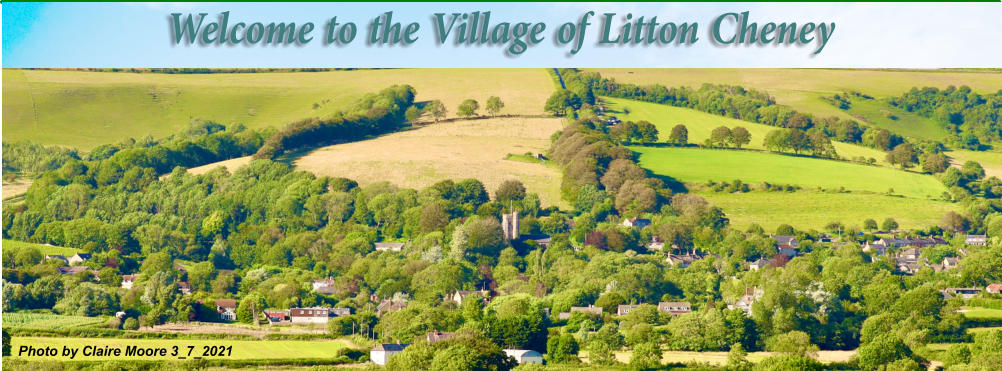Brenda lived most of her life in the countryside, but she was not a country girl. In fact, she
was London born and bred.
She had a difficult childhood. Her father contracted TB when she was an infant and, after a
long illness, finally died when Brenda was a teenager. This affected her greatly. In her
words:
“I’ve always felt so sorry for the young man who had all his ambitions cut short, to end in a
miserable heap of ill health. It can still make me cry. He died at 44.”
Whilst her family was initially prosperous, their fortunes declined with her father’s health.
The family moved first to Croydon, where she got shot at by a German airman during the
war, and then back to her birthplace of Hounslow, to live in a council house. But Brenda
was a bright and confident child, earning a scholarship to what might be called a “posh”
school, Godolphin and Latimer. Poorer than her peers, at one time her family was unable to
afford a new school uniform and in one class photograph she is seen standing out in in a
dark tunic amongst a sea of white shirts. But as she said: “these things never mattered”.
She already had the self- confidence to pay no heed to these incidentals.
Brenda stood out in other ways, earning entry to University, the first in her family to do so.
She chose to study science, an odd choice since it did not particularly interest her and she
did not excel in it. But as she explained recently:
“The real and only reason I took the science route was because I heard that the lad down
the road had just started scientific work at £15 a week!! ‘I could do that’ I thought. Our
family was living on £5 a week at that time.”
Like many of her generation, Brenda was careful with money, but she was never mean. She prided herself on her ability to make-
do and mend, to re-use and re-cycle. In hospital recently, she would proudly announce how the kaftan she was wearing was
purchased more than a quarter of a century ago.
Anyway, to return to her story: even if the scientific path was perhaps not best suited to Brenda personally, it was fortuitous in one
respect; it led her on an inexorable path to meeting Jim, her future husband and life partner. (I should point out here that Jim is Gil
and Gil is Jim. Brenda had just one husband. She called him Jim and, in this address, so shall I).
After Brenda and Jim left their respective universities, fate then placed them in close proximity, initially at a scientific research lab in
the leafy Surrey countryside and later – when their employer relocated them both – to a factory near Southampton docks.
How did Brenda catch Jim’s eye? There are two events that Jim recalls. Firstly, what he calls euphemistically a “change of fashion”
around that time. Those who were around then will understand what he is getting at. A church is not an appropriate place to be
going into more detail.
Secondly, he recalls a remarkable event, somewhere along a lane behind the research labs. A number of the researchers, Jim and
Brenda included, were taking a walk, when one of the men found a frog – or perhaps it was a toad – in the grassy verge, picked it
up and used it to scare some of the women. This did not scare Brenda, who was afraid only for the frog. She admonished the
show-off for frightening the little creature, took the frog off him, and carefully returned it to the grass. In an era when women were
expected to be seen but not heard, Brenda was confident enough to stand up to a bully. (And, incidentally, was not squeamish
about handling a frog.)
How many characteristics of Brenda does that vignette capture? Her firm beliefs. Her confidence o state them, no matter how that
might be received. Her standing up for the vulnerable. It may not be fanciful to even see here a nascent love of the countryside.
Certainly, it made a marked impression on a youthful Jim, such that he remembers it clearly almost 60 years later. It seems that
Brenda had also noticed Jim: for, as a friend of the time recalls:
“Brenda warned me off Jim. Not that Jim was unsuitable or that I was potentially interested. She simply wanted to keep Jim for
herself.”
Sometime after these two events, the dating and romance between Jim and Brenda began. How and when is unclear. Knowing
Brenda, it is very possible that she asked Jim out, rather than the other way around.
By this time, Jim was living in Lyndhurst, in the New Forest. But Brenda, not yet seduced … by the country life, returned to
London. Notwithstanding this, the romance continued, with Jim riding regularly up to London and back on his Lambretta scooter, a
formidable journey even today.
At this point, things started to move more quickly. Within 18 months they were married, living first in Lyndhurst and then moving to a
large house in Brockenhurst.
The Brockenhurst years were a busy and somewhat difficult time for Brenda. She had four children to raise and care for and
embarked on a new career as a book-keeper. But she still found time to ook after the vulnerable: in particular, giving literacy
lessons to young adults who had not properly learned to read at school. After many years, when the children had all left home and
Jim and Brenda neared retirement, they decided to move house again. They might have stayed in the New Forest or even returned
to their roots in London, but instead decided to head west, to a place many people regard as the middle of nowhere but locals know
to be the centre of the universe: Litton Cheney.
I think that the twenty three years Brenda lived in Litton were the happiest of her life. She found a depth of friendship and
community here that she hadn’t experienced elsewhere. And in saying that mean no disrespect to those friends of hers who have
come here today from Brockenhurst and elsewhere. Perhaps this is a place in tune with her values: of plain speaking and looking
after one another and particularly the vulnerable. We know that, only a few weeks before she became ill, she was still cooking and
delivering cakes to infirm neighbours.
For much of this period, Brenda was travelling the world with Jim. At least, this is how it seemed to my family, as we received
regular postcards from the couple from every corner of the world. But Brenda was always adventurous. When the children were
young, the family would drive west each summer holidays – and it was always west - to pitch a tent in a field somewhere and then
spend a fortnight exploring the dramatic cliffs, bays and beaches of Britain’s West coast.
Brenda loved walking. With or without Jim, she explored every footpath in the locality. The couple also trekked in more exotic
locations, with a group of ramblers who christened themselves the Marrakites, after the place they first met: Marrakesh. After she
died, her family discovered a letter that Brenda had recently written to a magazine, fiercely arguing for locals to preserve the
footpaths in their vicinity, despite government neglect. It is worth quoting an excerpt of what she wrote, as here we see Brenda in
rhetorical top gear, fighting for her beliefs:
“Have we become so used to our politicians bribing us with grants and privileges that we cannot see where our interests lie? For
better or worse, this Government has decided to stop spending, and many of its erstwhile activities are being abandoned. …In the
meantime, are we to cut off our noses to spite our faces? Do we want to walk these footpaths or not? They were kept alive before
the Government took a hand and we’ll want to walk after they’ve gone.”
Brenda and Jim’s marriage, like all marriages, had its ups and downs. But, when they looked back together on their fifty plus years
of marriage, they both agreed that there was nobody else whom they would or could have spent their life with.
Although we all knew the seriousness of her illness, we were still surprised how suddenly she passed away. But that was the way
she wanted it. She told us that she felt she had lived a full life, surrounded by loving family and friends. She was not afraid of
death, only of a long illness, which fortunately she was spared. She died peacefully in her own home, surrounded by family. And
almost until the end, she was still able to walk to the bottom of her garden, to gaze for the last time at the lovely view of the Bride
Valley and the hills beyond.
There is one last thing. As many of you will know, Brenda did not believe in God. But she did believe in this little church in Litton
Cheney, how important it is in providing a heart to the Litton community. It was her wish for there to be a service here, in her
memory, and we are grateful to the church for allowing this to take place.
When she was in hospital, a family member mischievously asked her whether now wouldn’t be an opportune time to reconsider her
atheism. “No” she said firmly. She had always lived her life according to one principle: “be true to oneself”. Or, in the words of
Polonius, in Shakespeare’s Hamlet:
“This above all – to thine own self be true; And it must follow, as the night the day, Thou canst not then be false to any man.”
As we know, Brenda could growl and snap, but she would rarely bite. And if her steadfastness, integrity and outspokenness made
Brenda a few enemies, it made her many more friends, many of whom are gathered here today. I implore you all not just to mourn
her passing but also to celebrate her full and happy life. That is how she would have wanted it.

BRENDA and GIL SMITH
Charlie Trott lived in the Village for over 60 years. The following tribute to Charlie was given by Tony Goverd at St Mary’s Church, Litton
Cheney, on14
th
July 2014.
Today we give thanks to God for the life of Charlie, remembering the man we knew, his friendship, good humour and love of steam. Charlie,
husband to Pearl, Dad to Roslyn, Elizabeth, Micky and Alison, was born on the 9
th
of August 1922 in the village of Cannington, Somerset, the
son of Pearcie and Effie Trott. He was actually named and baptised Thomas Charles - an old family name. He had a younger brother,
Bernard, who predeceased him.
The family moved to live at Wells, where father Pearcie was a steam lorry driver for the Somerset County Council, driving both Sentinels and
Fodens. Charlie was never to forget his first experiences of being driven in a steam powered vehicle. The fascination and memory of the
power of steam was to remain with him.
He was educated at the Wells Blue School, a grammar school. He was fond of the outdoors and a member of the Wells Sea Scout Troop. On
leaving school he obtained an apprenticeship with Westlands at Yeovil. Following the Battle of Britain major production of Spitfires was
switched to Westlands. Although in a reserved occupation, assembling aircraft held no attraction for him and he managed to get himself
conscripted to serve in the Royal Navy.
After basic training and gunnery school, Charlie joined a crew of 1200 as a gunner on a new steam turbined aircraft carrier HMS Unicorn.
Unicorn, a Repair Carrier, had 35 operational aircraft. The ship took part in U-Boat patrols in the Northwest Approaches and convoy escort
duties between the Home Fleet base at Scapa Flow and Gibraltar and Malta where he manned the ship's anti-aircraft guns against continued
air attacks. Unicorn also provided support for the amphibious landings at Salerno. Fitted with 4 twin turrets of 4 inch guns, she was the only
aircraft carrier during the war to use her guns to pound shore installations. After transfer to the Eastern Fleet based at Trincomalee, Ceylon,
there followed patrols in the Indian Ocean with visits to Bombay. Ordered to Durban, South Africa, the ship was refitted and sent to join the
Pacific Fleet where she was dive-bombed by a Japanese Kamikaze pilot. Charlie lost shipmates when a gun turret caught fire. It was only the
sudden list of the ship that saved his turret. With preparations under way for the invasion of Japan, Unicorn was used in a support role,
providing air cover at the invasion of Okinawa. During her service, hundreds of aircraft sorties were flown from the carrier, sadly not without
loss.
Charlie enjoyed his naval service. He was a great storyteller, mindful of events experienced. With great humour, he would recall the happy
times and of his escapades ashore. Ever resourceful, whilst ashore in Durban, he managed to arrange his own sight-seeing trips when he
became the driver of a jeep actually allocated for officer use. A similar situation was to avail itself when the ship made harbour in Brisbane
some months later. It was in Durban that South African soprano, Perla Siedle Gibson, 'The Lady in White', sang to troop and warships as they
came and went from harbour. Her performances as she responded to requests for popular songs were a highlight for many visiting ships.
Years later, when relating the experience, Charlie was heard to jest: “I wish she would come and sing to me”! When peace was declared on
the 15* August 1945, Unicorn was at the Manus naval-base in the Admiralty Islands and eventually docked in Sydney. There, with thousands
of matelots ashore, including Americans and Australians, he described the situation as “lively”! He recalled with gratitude the overwhelming
hospitality he enjoyed in Australia and, as ever, had many a tale to tell. The Unicorn was eventually nominated to return to the UK and arrived
at Devonport on the 16
th
January 1946. Charlie's Navy days were over but the experience remained for ever in his memory.
On demob, he did not return to work at Westlands but took a job as a vehicle mechanic with The Bristol Omnibus Company at its Wells depot.
He was to recount that working there, especially after nationalisation in 1948, could well have been the basis for the eventual script for the
sitcom 'On the Buses', complete with an inspector that could double for 'Smiler'. The time had come to move on.
In 1953 there was a total career change and approach to work. Charlie, Pearl and the family moved to Litton Cheney where he took a job as a
painter and decorator with Fry and Son. At the time Charles Fry was not only a local builder but also an undertaker. With just 6 employees,
Charlie found himself called upon to undertake a number of tasks including that of pallbearer. In the 1950's and 60's West Dorset was in a
time warp - this suited Charlie. A Somerset man by birth, he became Dorset by adoption. He worked for the Frys for 34 years during which
time he undertook numerous specialised tasks, such as wallpapering the hall at Kingston Russell House with hand blocked paper specially
imported from China. The firm grew and Charlie became known for the quality of his work. He became somewhat of a father figure, offering
advice and guidance, especially to young apprentices - a 'Mr Fixit'. Even after he retired his services were still called upon, a real friend to the
village where he lived for over 60 years.
In 1960 Charlie and the late Ron Wilcox acquired a Burrell single cylinder general purpose traction engine, 'Duke of Windsor’, which, built in
1895, was in a sorry state. There was much shaking of heads that the engine would ever be restored. Although it took over two years to
achieve working order, as engineer on the project, Charlie proved his mettle. The engine subsequently proved a great attraction. Charlie and
Ron often took part, with Dr Giles Romanes from Portesham and his Wallace and Stevens engine 'Goliath', in mini-rallies, with suitable
'watering holes' in mind. Charlie merged well with the other characters who at that time were also steam locomotion enthusiasts. Over the
years, the engine attended numerous venues including Litton Fete, Bridport Boxing Day Pram Race, Gore Cross Rally, Weymouth Carnival,
Yeovil Festival of Transport, Yesterdays Farming and 'Stourpaine'…. the list goes on.
In 1967 the Burrell engine and associated threshing machine was commissioned for use in the filming of a scene in the Metro-Goldwyn-Mayer
film ‘Far From the Madding Crowd’, directed by John Schlesinger and starring, amongst others; Julie Christie and Alan Bates. Three weeks
were spent by Charlie and Ron in filming, only for a few minutes to be shown on screen. However, the engine and its operators became stars.
In 1968 Charlie became a founder member of the Dorset Steam and Historic Vehicle Club which in 1969 combined with Michael Oliver to put
on a steam rally at Stourpaine that was eventually to develop into the Great Dorset Steam Fair.
Charlie and Ron took part in the Steam Fair with the Burrell engine and
threshing rig over a number of years until the ‘Duke of Windsor’ was sold.
Charlie, looking for another challenge, acquired an Aveling and Porter Steam
Roller which he restored to working order and named 'Charlie's Darling'. This
was sold in 1996. Pearl was very supportive of his hobby – by no means a total
'steam widow’. He acquired 'Roller Man's' vintage caravan, which he
refurbished so that she could accompany him, and they both enjoyed the
'Stourpaine experience' and other day shows in comfort. Regular in his
attendance at the Steam Fair, he did the rounds, always prepared to share his
wealth of knowledge and expertise. He was never without a project. More
recently he totally rebuilt and modified a vehicle powered by an American
‘Mason' steam car engine. So, for over 50 years, Charlie was a 'steam man’.
My old friend, yours has been a life lived to the full, with love abounding for Pearl
and the family. During the last difficult year, your strength of character ever
present, you expressed a wish to stow your hammock and so it was the Lord
called you to muster. You lived life with good humour giving many a helping
hand along the way. Your philosophy on life is perhaps summed up in this prayer, words couched in the vernacular - copied for me many
years ago by Pearl using her calligraphy skills.
Give us Lord a bit o'sun, a bit o'work and a bit o'fun.
Give us, in all the struggle and sputter, our daily bread and a bit o'butter.
Give us health, our keep to make and a bit o'spare for others’ sake;
Give us too a bit o'song and a tale and a book to help us along.
Give us Lord a chance to be our goodly best, brave, wise and free;
Our goodly best for ourselves and others ‘til all men learn to live as brothers.
Until we meet again - God Bless.
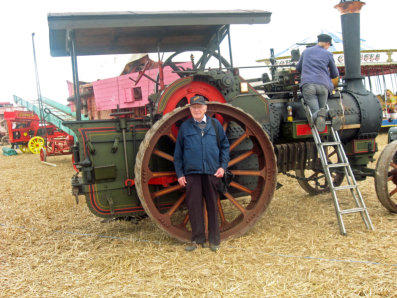
Charlie and ‘Duke of Windsor’ - 1988 Great Dorset Steam Fair
ADDENDUM - HMS Unicorn
HMS Unicorn was an aircraft repair ship and light aircraft carrier built for
the Royal Navy in the late 1930s. She was completed during World War II
and provided air cover over the amphibious landing at Salerno, Italy, in
September 1943. The ship was transferred to the Eastern Fleet in the
Indian Ocean at the end of the year. Unicorn supported the aircraft carriers
of the fleet on their operations until the British Pacific Fleet (BPF) was
formed in November 1944. She was transferred to Australia in early 1945
to support the BPF's operations during Operation Iceberg, the Allied
invasion of Okinawa in May. To shorten the time required to replenish the
BPF's carriers, the ship was based in the Admiralty Islands and in the
Philippine Islands until the Japanese surrender in August. Unicorn was
decommissioned and placed in reserve when she returned to the UK in
January 1946.
The ship was recommissioned in 1949 to support the light carrier of the Far
East Fleet, as the Eastern Fleet had been redesignated after the end of
World War II. She was unloading aircraft and equipment in Singapore in
June 1950 when the Korean War began. She spent most of the war ferrying
aircraft, troops, stores and equipment in support of Commonwealth
operations in Korea. Unicorn supported other carriers during operations in
Korea, but she became the only aircraft carrier to conduct a shore
bombardment with her guns during wartime when she attacked North
Korean observers on the coast during the war. The ship returned to the UK
after the end of the war and was again placed in reserve. She was listed for
disposal in 1958 and sold for scrap in 1959.


HMS Unicorn at Trincomalee, Ceylon in 1944
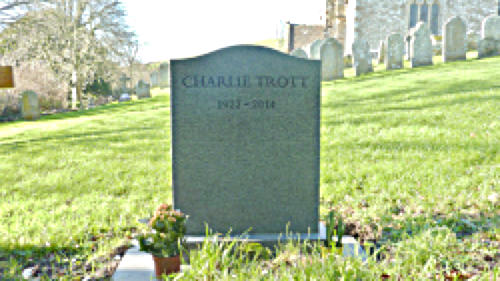
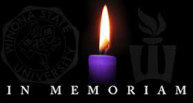
PEARL and CHARLIE TROTT




IN MEMORIAM - CONTEMPORARY
Select Name
ABOUT LITTON CHENEY



Charlie 1922 – 2014
Pearl 1925 – 2021
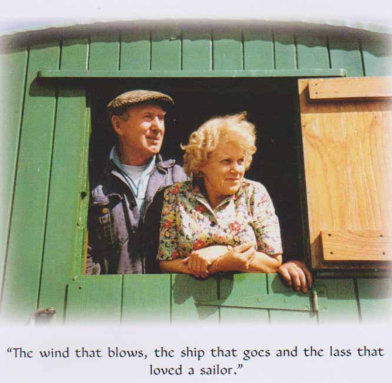
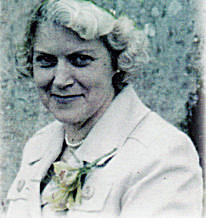
Eulogy Nov 30
th
2021
Pearl was born in Somerset in 1925 and lived there until 1952 when she moved to Litton Cheney with her husband and children.
She was a very good cook and had several jobs in the village cooking and would always make cakes for the Village Fete and apple
tarts for the Harvest Supper.
She was very good at patchwork and made quilts and cushions.
She went to classes to learn calligraphy and would produce beautiful pieces of writing.
She learnt to paint and painted lovely pastoral scenes
She loved nature and liked watching the birds in the garden and going for walks with Charlie and their dog Jack.
During the summer months she would go to steam rallies with Charlie.
Thank you for coming today to celebrate the life of my lovely dad known as James, Jim and Gil
Smith. His much loved wife Brenda sadly died almost 10 years ago. Dad is mourned by his four
children, Philip, Isobel, David and Alan, their partners Mandy, Scott, Caroline and Jane, his 7
grandchildren, and 4 great grandchildren. He is also mourned by his many friends.
Dad was an only child, born in 1932 in Hatchend in North West London. His father Gilbert worked as
a senior manager at Kensitas, a cigarette company. Sadly, Dad’s father died suddenly when dad was
only 17. Thus as a young man he stayed at home to support his mother, which was an early sign of
Dad’s care and compassion. He studied at the University of London, Kings College and graduated
with a Bachelor of science in Physics in 1954. His first job was at Mullards, where he met his wife-
to-be, Brenda. He moved to Southampton University in 1968 where he worked until he retired. Dad
thoroughly enjoyed his work and became lifelong friends with many of his colleagues. He took
sabbaticals in Kenya and Australia, and travelled to various other countries, including India, Egypt,
and Scotland.
Dad was a man of his time. Thus he was rather less hands-on with his babies than fathers tend to be
now and my recollection is that we fitted around mum and dad’s chosen activities, rather than them
following us around. This was probably more interesting for both adults and children than the other
way. Sport never interested dad. He thought more collaboration and less competition would make
the world a much nicer place.
Whilst they lived in the New Forest where we four kids grew up they were keen members of the New Forest Wine Circle, which
involved a lot of making and drinking wine. We children would assist in gathering buckets of blackberries, elderberries or primroses
from the New Forest to make the wine. They both won a few local awards for winemaking and wine judging, but the real richness of
the Wine Circle were all their social events and all the friends that they made, many remained close friends throughout their lives.
Dad worked hard maintaining the house, garden and car and we were certainly expected to join in the work because that was
integral to being a family. He taught us many useful skills around the house and garden. For example, we all learnt to paint on their
wooden sailing dingy which needed painting before being launched each summer.
Dad wasn’t demonstrative in a classic sense, but we are quite certain that he loved us, his children and grandchildren, deeply. He
showed that in his actions and care, being on hand to provide practical support and help in all manner of things when we needed it.
He delighted in taking us to the places he loved and sharing things he liked doing with us. Those grandchildren who grew up in
England remember him as being great fun. He and mum regularly had them to stay, to help out Alan and I, and to provide some
adventures for them. Dad once very kindly let my 6 year old son Matthew help him fix the weathervane on top of the roof.
Throughout their lives Mum and Dad valued their friends very highly and loved social events. Dad’s role was mainly entertainment.
His invitation could be elaborate, as you’ve heard, and he often organised some novel decorations. Dad also revelled in being the
person keeping the party lively. He could recite all 8 verses of Robert Burns poem ‘Ode to a Haggis’. More than once I video linked
him into our Burns night celebrations in Sydney to recite that essential part of the evening’s formalities. Dad was very quick with
numbers, and friends recall how adept he was at quickly working out which day of the week someone was born on. A friend from a
walking group recalls that dad was a lively companion to walk along with and that he took brain teasers and stories along to their
weekends away. At one party to test a psychology theory about people’s power of observation, dad swapped shirts with a friend of
mine. Curiously no one did notice, despite dad swapping his gold lame shirt for a very sedate one.
All of you will know of Dad’s creativity and penchant for inventions, so many over the years. Back in the mid 70’s Dad worked his
electronic magic so that our garden gates opened when the car headlights were flashed on them. It worked beautifully and did save
someone getting out of the car to open them and having the long arduous 10 second walk up the drive to the house. Unfortunately,
on a windy sunny day the overhead trees created moving shadows that could keep the gates opening and shutting for hours. People
walking past were astonished, and the local new forest ponies were delighted to stroll in freely for a feed of mum’s garden flowers.
On a professional level I found a patent he was granted for an anti-fogging transistor in 1965, and he appeared on the BBC
television show “Tomorrow’s World” in the 1990s, demonstrating his trackable Pebble on a beach.
He was always energetic and adventurous and disliked wasting time. In 1962, leaving mum at home with 2 babies, James went as
part of the electronics team in a group searching for the Loch Ness Monster. They were written up by several articles in national
newspapers but didn’t find the Loch Ness Monster. As a young family we went for many walks in the New Forest. These frequently
involved mild misadventure such as getting somewhat lost, or trying to swing over a river on a rope and falling in. We also often
went sailing. Looking back we realise how adventurous, or risky, it was for our family of 2 adults and 4 young children to sail around
the Solent in his 14 foot wooden sailing dingy. Much later, when dad was 60 he joined me on a trip attempting to raft down a remote
river in Borneo. His mother-in-law inadvertently clinched his decision to come along by saying “a man of your age, rafting in Borneo,
how ridiculous”.
Dad was very sociable and a lot of fun to be around. His jokes and quirky humour were well known and were a delight to his young
children and grandchildren. People he’d just met could be taken aback by his unorthodox humorous style, but as mum fondly said,
“he won people over”. This humour could go awry. On a work trip to Cuba in 1972, an inappropriate joke led to him being tailed by
stern looking men in suits, to keep him in check. On another occasion Dad was asked to provide a reference for a friend of his, Ray
Hawthornthwaite, to emigrate to Canada. Dad related that the reference interview was going well until he joked straight faced that
“of course you know his name has Russian connections”.
Mum and dad retired to Litton Cheney, a little village on the Dorset south coast, where they lived for 25 years. They loved it there
and joined in village life enthusiastically, including frequenting the White Horse pub. Dad believed that local communities were really
important, and he now had more time to offer support. He served on the Parish Council for several years and was instrumental in
the foundation of the Village website in 2003. He also campaigned and worked hard with other local people to get a Community Hall
for Litton Cheney, which was built in 2009 to his delight. Living in Litton was also wonderful for him because of the beautiful
countryside which he so appreciated.
Once retired mum and dad took enthusiastically to holidays around the world, often with friends. In 1988 they went to Morocco on a
walking holiday meeting a lovely group of people. They all got on so well that they called themselves the Marrakites and met up
twice a year for a walking weekend for many years. Mum and dad were wonderfully intrepid and energetic right through their 70s.
After mum died dad moved to Cambridge to the flat they had chosen together. Despite being 83 and being widowed dad determined
to have a positive life in Cambridge. He signed up for U3A courses and delighted in exploring the old buildings and local villages. He
met a lovely lady, Sylvia, who became such a close and caring friend over dad’s last years. Dad also enjoyed being able to see
Philip each week.
I don’t know exactly what drew mum to choose to marry dad. She mentioned that early in their friendship he forgot her birthday so
she knew he wasn’t perfect. So what won her over must have been the qualities that we all knew, his qualities of fun, friendliness,
adventure, creativity, loyalty and wanting to make the world a closer community. I am awed by dad’s energy and enthusiasm in living
life to the full, and in the richness of his life. We will miss him enormously.
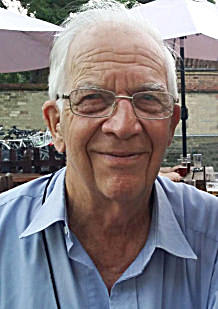
Brenda 1934 - 2013 The following eulogy was given at a celebration of her life on Monday the 19th of August 2013:
